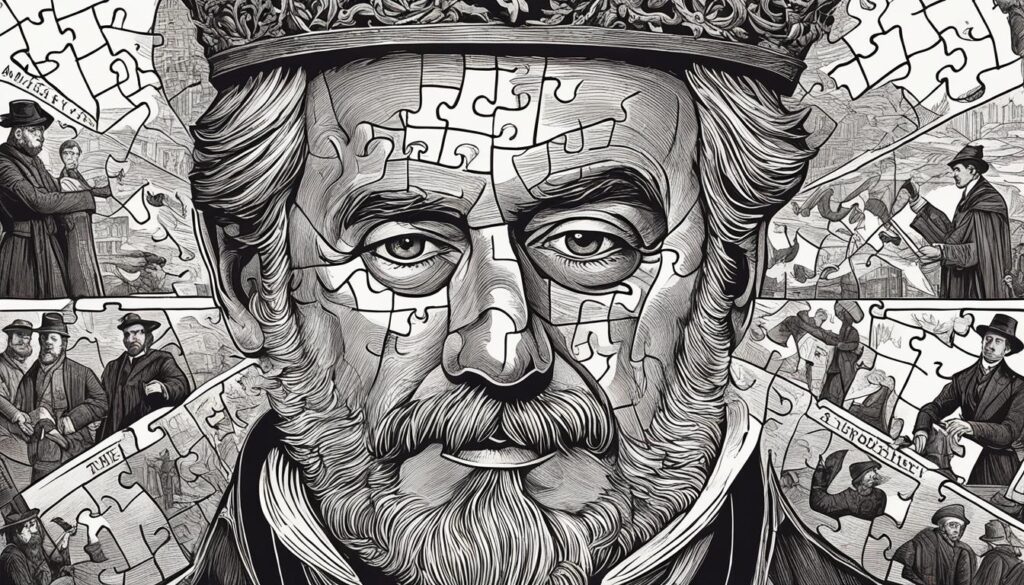In this audiobook review, we will be diving into the haunting world of “The Historian” by Elizabeth Kostova. Follow our journey as we explore the fusion between history and vampiric lore. Kostova’s storytelling has captivated readers for years, and with the audiobook format, it’s an entirely new experience. Let’s delve deeper into the intricacies of this novel and explore what makes it a must-listen.
Key Takeaways
- Elizabeth Kostova’s “The Historian” is a captivating novel that uniquely blends the worlds of history and vampiric lore.
- The audiobook format of the novel provides a new and compelling experience for readers.
- The story’s rich characters, intricate writing style, and exploration of vampiric themes make it a must-listen for fans of the genre.
- “The Historian” has received critical acclaim for its impact on readers and the literary world.
- Readers who enjoy vampire novels will find similarities with other popular books in the genre, but Kostova’s approach remains unique.
Overview of “The Historian”
First published in 2005, “The Historian” by Elizabeth Kostova is a captivating novel that weaves together the genres of historical fiction and horror. The story centers around a young woman who discovers a mysterious book in her father’s library, setting her on a journey to uncover the truth about her family’s past and the legend of Vlad the Impaler, the historical figure who inspired the fictional character of Dracula.
Kostova’s novel spans multiple time periods and locations, from the medieval Ottoman Empire to the post-World War II era, painting a vivid and engaging portrait of the past. Throughout the story, readers are drawn into the suspenseful world of vampiric lore, encountering a cast of fascinating characters along the way.
The novel’s key themes include the pursuit of knowledge, the search for identity, and the complicated relationship between history and myth. Kostova’s writing style is rich and atmospheric, immersing readers in a world of mystery and fear.
The Plot
| Event | Description |
|---|---|
| Part I: 1950s | The narrator, a young girl, discovers a book addressed to her which contains a letter and Dracula imagery later on laying out a history of Vlad the Impaler. She becomes interested in the story and asks her father more about it. |
| Part II: 1970s | The father of the narrator goes missing. It is revealed he had been researching Vlad the Impaler, and the narrator becomes interested in this research as well. They embark on a mission to find the missing father and continue his research. |
| Part III: 1930s-1950s | The story of the father of the narrator is revealed through a series of letters, and his history with Professor Bartholomew Rossi who was also researching Vlad the Impaler, including his time in Istanbul and at an academic conference in Budapest where he met and fell in love with a woman named Helen. |
| Part IV: 1970s | The narrator and her father locate Rossi’s castle and discover the truth behind his obsession with Vlad the Impaler. The father goes missing again while the narrator meets Helen. |
| Part V: 1970s | The narrator and Helen join forces to find the missing father, culminating in a confrontation with the ancient vampire and the revelation of the narrator’s true identity. |
Overall, “The Historian” is a chilling and captivating novel that explores the intersecting worlds of history and vampiric lore. It is a must-read for fans of Gothic fiction, historical fiction, and horror.
The Historical Context in “The Historian”
The historical context plays a significant role in Elizabeth Kostova’s novel, “The Historian.” Through its vast range of time periods and locations, the novel weaves together historical events and figures with vampiric lore, creating an intricate and compelling narrative.
The story begins in the 1950s, as a young woman discovers a mysterious book and a cache of letters belonging to her father. The letters detail his obsession with Dracula and his search for the elusive vampire. Moving back and forth through time, the novel takes readers to the 1930s, where the father’s own search began, and to the 15th century, where the source of the Dracula legend is believed to originate.
The historical settings of “The Historian” are richly detailed, bringing to life the cultures, customs, and landscapes of the various locations. From present-day Amsterdam and Istanbul to medieval Wallachia and Ottoman-occupied Bulgaria, the novel immerses readers in the historical contexts that shape the characters and their experiences.
The novel’s exploration of the Ottoman Empire and the Byzantine Empire, in particular, provides a nuanced understanding of the regions’ histories and the complexities of the relationships between various cultures and religions. The descriptions of the architecture and landscapes add to the vivid historical context and imbue the story with a sense of place.
Overall, the historical context of “The Historian” contributes to its richly layered narrative and adds depth to its exploration of vampiric lore. By incorporating historical events and settings, Kostova weaves together a complex tapestry of history and mythology that captivates readers and keeps them engaged until the very end.
Character Analysis in “The Historian”
Elizabeth Kostova masterfully develops an array of dynamic characters within “The Historian.” Each person serves a purpose and adds depth to the plot, making it difficult to distinguish between primary and secondary characters.
The protagonist of the story is a nameless narrator and historian who sets out to uncover the truth about Dracula and his whereabouts. The narrator’s analytical and methodical nature juxtaposes against his father Paul, an impulsive and inquisitive historian who initially sets the narrator on his quest.
Dracula is portrayed as a fascinating character, and the myth surrounding him is the driving force behind the story’s suspense. Kostova gives Dracula’s character depth through the journal entries that the narrator discovers along the way, showcasing a complicated and tormented soul.
The female characters in the novel all possess resilience and intelligence, challenging the male characters’ preconceptions and expectations. Helen Rossi, Paul’s former assistant, helps the narrator piece together the shocking truths about Dracula’s existence. Margaret and her daughter, also named Margaret, play pivotal roles in the story’s development, leaving a lasting impact on the narrator’s journey.

The characters in “The Historian” all have significant motivations and relationships, driving the plot forward and building a riveting narrative. Their complexities and varied personalities make for a captivating read that keeps the reader engaged until the very end.
Writing Style and Narrative Techniques
Elizabeth Kostova’s writing style in “The Historian” is characterized by its atmospheric and descriptive nature. The author’s use of language paints a vivid picture of the story’s settings and characters, immersing the reader in the intricate world of vampiric lore. Kostova’s pacing is deliberate, allowing for the gradual unraveling of the plot and the development of the story’s themes.
Kostova employs various narrative techniques in “The Historian” to create a multi-layered reading experience. The novel is presented through multiple perspectives, with different characters contributing pieces to the overall puzzle. The author also utilizes epistolary elements in her writing, incorporating letters and documents that provide crucial insights into the story’s mysteries.
One of the most notable narrative devices used in “The Historian” is the story within a story structure. Kostova weaves together multiple timelines and locations, seamlessly blending historical events with the realm of Gothic horror. The result is a richly textured narrative that fully immerses the reader in the unique world of the novel.
Kostova’s Language
Kostova’s language is both haunting and lyrical, evoking a sense of mystery and foreboding that permeates the entire novel. The author’s attention to detail is evident in her meticulous descriptions of the various settings, capturing the essence of each location with precision and nuance. From the winding streets of Istanbul to the shadowy forests of Eastern Europe, Kostova’s writing transports the reader to another time and place.
Pacing and Structure
The deliberate pacing of “The Historian” allows for a gradual buildup of tension that culminates in a satisfying conclusion. Kostova’s use of historical flashbacks and multiple perspectives adds complexity to the narrative, providing a multifaceted exploration of the novel’s themes.
Epistolary Elements and Story Within a Story
Kostova’s incorporation of epistolary elements adds another layer of intrigue to the novel. The letters and documents that are interspersed throughout the narrative provide essential clues that propel the story forward. Additionally, the story-within-a-story structure creates a complex, multifaceted narrative that keeps the reader engaged until the very end.
Vampiric Lore and Themes in “The Historian”
“The Historian” expertly weaves together historical facts and vampire mythology to create a captivating story full of rich themes.
Exploration of Folklore and Mythology
The novel explores vampiric lore in great depth, delving into the various myths and legends surrounding these dark creatures. From the origins of vampires to their powers and weaknesses, “The Historian” brings these aspects to life in a new and compelling way.
The Portrayal of Vampires
The vampires in “The Historian” are depicted as multi-dimensional characters with complex motivations and relationships. Rather than being portrayed as one-dimensional monsters, they possess a level of humanity that makes them both compelling and unsettling.
Thematic Depth
The novel tackles a variety of themes, including the nature of evil, the complexities of historical research, and the importance of family ties. The story also highlights the dangers of obsession and the lengths people will go to in pursuit of knowledge and power.
| The Themes of “The Historian” | Description and examples |
|---|---|
| The Nature of Evil | The novel explores what it means to be evil and how it affects individuals and society as a whole. For example, the ancient vampire Dracula is portrayed as both charming and terrifying, highlighting the duality of evil. |
| The Complexities of Historical Research | The story uncovers the challenges and nuances of researching historical events and the importance of presenting an accurate picture of the past. The historian characters in the novel grapple with issues such as bias, perspective, and the difficulty of filling in the gaps of history. |
| The Importance of Family Ties | The novel emphasizes the significance of family connections and legacy. Characters must navigate their relationships with their parents and ancestors while grappling with the long-reaching consequences of their actions. |
The vampiric lore and themes in “The Historian” contribute to the novel’s complex and thought-provoking narrative. Readers are left contemplating both the literal and figurative meanings behind the story, making it a must-read for fans of vampire literature and historical fiction alike.
Audiobook Narration and Performance
When it comes to audiobooks, narration and performance are crucial components that can make or break the overall experience. In the case of “The Historian,” the audiobook version delivers an immersive and engaging performance that does justice to the gripping storytelling of Elizabeth Kostova.
The audiobook features a talented cast of voice actors who bring the various characters to life with unique vocal quirks and emotional resonance. Their performances are nuanced and authentic, adding depth and dimensionality to the already richly-developed characters.
The pacing of the audiobook is also noteworthy, with a consistent rhythm that builds tension and suspense in all the right moments. It never feels rushed or too slow, maintaining a steady flow that keeps the listener engaged throughout the entire story.
Overall, the audiobook production quality is of top-notch standard, with clear and crisp sound quality that allows listeners to fully immerse themselves in the world of “The Historian.”
In conclusion, “The Historian” audiobook narration and performance sets the bar high for other audiobooks and enhances the overall narrative experience.
Reader Reception and Critical Acclaim
Since its publication in 2005, “The Historian” has garnered significant reader reception and critical acclaim. Many readers have praised Elizabeth Kostova’s masterful storytelling, immersive world-building, and complex characters. Some have even cited the novel as one of the best vampire novels of all time.
Critics have also lauded “The Historian,” with many notable publications such as The New York Times Book Review, Publishers Weekly, and Library Journal giving it positive reviews. The novel was a #1 New York Times Bestseller and a Bram Stoker Award finalist.
The widespread critical acclaim and reader reception of “The Historian” firmly establish it as a notable addition to the vampire genre and a captivating read for anyone seeking an immersive and thought-provoking novel.
Comparison to Other Vampire Novels
While “The Historian” is a uniquely crafted novel, it shares common themes and motifs with other popular vampire novels. Let us compare it to two other notable works in the genre:
Twilight by Stephanie Meyer |
Dracula by Bram Stoker |
|
|---|---|---|
| Themes | Love and forbidden romance | Victorian England, sexual repression, and xenophobia |
| Writing Style | Simple and poetic language catering to a younger audience | Ornate and verbose prose catered towards literary audiences |
| Narrative Approach | First-person narration from the perspective of a teenage girl | Epistolary format with multiple narrators |
Compared to “Twilight,” “The Historian” offers a more mature and complex narrative that explores history, religion, and mythology. It employs a third-person multiple narrators’ approach with a deep focus on character development.
Similarly, while “Dracula” deals with vampiric lore, “The Historian” shares the gothic themes of good versus evil and the supernatural interwoven with history. Yet, “The Historian” explores these themes through a contemporary lens, making it more accessible to modern readers.
Overall, “The Historian” provides a more nuanced and intellectually gratifying vampire reading experience than its peers.
Conclusion
After a thorough analysis of “The Historian” audiobook, we can confidently say that it is a captivating and well-crafted story that seamlessly intertwines history and vampiric lore. Elizabeth Kostova’s writing style and narrative techniques are effective in creating a chilling and immersive atmosphere that keeps listeners hooked from start to finish.
The historical context of the novel adds depth and substance to the plot, while the characters are convincingly developed and nuanced. The exploration of vampiric lore and themes is thought-provoking and engaging, making “The Historian” a standout in the genre.
The audiobook narration and performance are of high-quality, enhancing the overall experience for listeners. The voice actors effectively capture the tone and mood of the story, keeping pace with the narrative and immersing the reader into the world of “The Historian.”
Reader reception of the novel has been positive, and it has received critical acclaim for its originality and skillful execution. As a whole, “The Historian” audiobook is a must-listen for fans of the genre and anyone looking for an engrossing and well-crafted story.
In conclusion, we highly recommend “The Historian” in its audiobook format and believe it’s worth experiencing for anyone who enjoys a captivating and thought-provoking tale.



